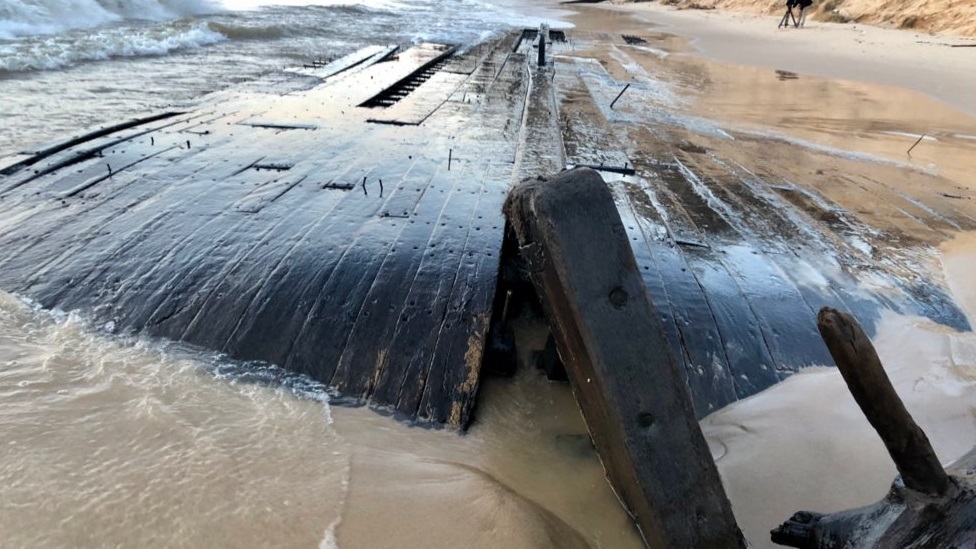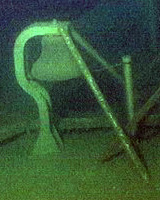Thousands of Resources, Ready to help.
Advantages
Popular

2025 Michigan Archaeology Poster
Twenty-Nine Bells: Remembering the Edmund Fitzgerald
On November 9, 1975, the lake freighter Edmund Fitzgerald steamed out of the harbor at Superior, Wisconsin, with a cargo of iron ore bound for Detroit. The following evening, in a ferocious storm, the Fitzgerald sank in eastern Lake Superior, without a distress call. All 29 crew members perished, devastating the lives of their families, friends, and fellow sailors.
A limited number of posters featuring the dramatic original artwork were produced in October 2025, but you can download and print your own from home! Click the link below to access the poster, and learn more about the Edmund Fitzgerald and shipwreck preservation on this webpage.
Archaeology is the study of human history by investigating the material remains, objects, and buildings we create and use.
Archaeology can make the history of a place tangible and connect us to people who once walked in the same places we step today. Traces of the past may often quite literally be buried beneath our feet, even in places where no evidence remains on the surface. While the landscape may transform and change, there can still be archaeological deposits intact, revealing the stories of those who lived there before us.
The same is true on the water. Water, particularly the cold fresh water of the Great Lakes, is a highly functional preservation environment. For generations, the Great Lakes have served as the super highways of this region, and evidence of this tangible history remains intact on the lakebed. The Great Lakes and Great Lakes Shipping are a fundamental part of Michigan's history. Maritime archaeologists explore submerged sites such as shipwrecks, helping us learn about those who sailed across our inland seas before us by studying what objects remain.
This poster remembers the sinking of the Edmund Fitzgerald on the 50th anniversary of its loss. The modern tragedy of the Fitzgerald in particular has become part of the lore of the Great Lakes, inspiring emotional artwork, music, and intrigue into its disappearence. But the Fitzgerald is far from alone. As many as 6,000 ships have been lost on the Great Lakes, including an estimated 1,500 in Michigan waters. The preservation of shipwrecks, such as the Edmund Fitzgerald, is important so archaeologists can better understand the lifeway of the people who built, operated, and went down with the ship.
The Edmund Fitzgerald
The Great Lakes and the rivers that connect them comprise the largest freshwater system on earth. Many of the communities that rely on these waters have become inextricably linked to the movement of raw materials for heavy industry and the large ships that carry loads across the lakes. The most well known of these ships is the Edmund Fitzgerald, which became the largest ship on the Great Lakes when it was launched in 1958 at Ecorse, Michigan, just south of Detroit. Measuring 729 feet in length, the Fitzgerald could carry more than 26,000 tons of cargo, typically iron ore used for steelmaking.
As the largest vessel on the Great Lakes at the time of construction, the “Fitz” became the flagship of Cleveland-based Columbia Transportation Company and made regular round trips between the Lake Superior iron range and Detroit, Toledo, or Cleveland. This massive vessel set several cargo records during its sailing career and was a favorite among boat watchers. Tragically, after 17 years on the Great Lakes, the Fitzgerald got caught in a ferocious storm on Lake Superior and sank on November 10, 1975. All 29 crew members perished, devastating the lives of their families, friends, and fellow sailors. The location of the wreck was positively identified in May 1976.
The Edmund Fitzgerald is intertwined with Michigan History:
• Designed and built by the Great Lakes Engineering Works shipyard at Ecorse, south of Detroit
• Passenger accommodations on board were furnished by the J. L. Hudson Company of Detroit
• The Fitzgerald’s regular trading route was through Lake Superior and the Soo Locks, down Lake Huron, then through the St. Clair and Detroit Rivers to unload at either Detroit or ports on Lake Erie
• On its last voyage in November 1975, the cargo was destined for the steel mill on Zug Island, just outside of Detroit
• The final resting place of the Fitzgerald and 29 crew members is 530 feet deep on bottom of Lake Superior, just across the international boundary between Ontario and Michigan
Despite technically sailing in Canadian waters at the time of its wreckage (as part of Lake Superior falls within Canadian territory) the crew members of the vessel were all covered by the Jones Act, as the Fitzgerald was flying the American flag and was owned by an American shipowner. Under the Jones Act, many surviving family members were able to receive financial compensation for the losses they suffered.
The wreck of Edmund Fitzgerald helped to bring about new safety protocols and changes were made to maritime law. After conducting a survey of the wreckage and the surrounding area, the Coast Guard implemented a series of changes to Great Lakes shipping practice to help prevent further loss of life. Eight of these regulations are still in place today, including the use of survival suits, emergency beacons, and improved navigational charts for many American bodies of water.
In Michigan, there are both National and State laws that aim to protect shipwrecks and other submerged sites. The Abandoned Shipwreck Act of 1987 is a Federal law that recognizes the importance of shipwrecks as cultural sites. The U.S. Submerged Lands Act of 1953 establishes that states manage submerged cultural sites on state bottomlands.
It is important to recognize that while not all shipwrecks are grave sites, many are and continue to be final resting places, including the Edmund Fitzgerald.
Archaeological investigations of shipwrecks in Michigan waters require a permit from the Department of Natural Resources. Part 761 of the Michigan Aboriginal Records and Antiquities Act prohibits the removal, alteration and destruction of shipwrecks or associated artifacts. While diving on shipwrecks is allowed under State and Federal law, it is illegal to move or recover objects or artifacts from shipwrecks in Michigan. Part 761 also prohibits removal or defacing of any human remains associated with shipwrecks. In Canadian waters, laws including the Wrecked, Abandoned or Hazardous Vessels Act and the Ontario Heritage Act, R.S.O. 1990 protect shipwrecks with historical or archaeological value, requiring a permit for any individual to dive on cultural resources. Failure to secure a diving permit could result in a $1 million fine.

You're walking along the beach and
Wait, is that part of a shipwreck?
As the Great Lakes shores erode and lake levels change, historic sites including shipwrecks, parts of historic vessels, artifacts, abandoned docks, pilings, maritime landscapes, and prehistoric objects may be exposed. Members of the public and citizen scientists can report such finds to the State of Michigan. Information submitted will be included in the State Archaeological Site File, the official record of terrestrial and bottomland archaeological sites in Michigan.
To prevent damage to historic sites, investigate the find only with your eyes and leave all artifacts in place. Document the find with photographs, sketches, maps, and GPS coordinates.
Why Shipwreck Preservation is Important
Submerged cultural resources, like shipwrecks, provide a unique glimpse into the past. Naturally preserved by the cold, freshwaters of the Great Lakes, shipwrecks are often a snapshot of a moment in time. Archaeologists can learn about past human behavior by studying these preserved moments. Preservation of shipwrecks, such as the Edmund Fitzgerald or the wooden freighter Joseph S. Fay pictured here, is important so archaeologists can better understand the lifeway of the people who built, operated, and went down with the ship. Questions about maritime history including shipbuilding, technology, navigation, and trade can be addressed by underwater archaeologists. Damaging or removing parts of sunken ships changes the context of the site and therefore alters the story that can be learned.
Every November, remembrance ceremonies are hosted at several places around the Great Lakes to honor those lost in shipwrecks. An annual ceremony is held on November 10th at the Great Lakes Shipwreck Museum at Whitefish Point where a bell is rung 29 times, once in honor of each crew member lost on the Edmund Fitzgerald.

29 Bells: Edmund Fitzgerald crew manifest
Click HereArchaeology 101
Michigan Archaeology Day | Michigan History Center
Michigan State Historic Preservation Office (SHPO)
Archaeology Program | Michigan SHPO
Michigan Archaeology Month | Michigan SHPO
Archaeology Laws | U.S. National Park Service
National Historic Preservation Act of 1966 | U.S. National Park Service
Underwater Archeology | U.S. National Park Service
Edmund Fitzgerald Collection | Detroit Historical Society
Edmund Fitzgerald | Great Lakes Shipwreck Historical Society
The Fateful Journey | Great Lakes Shipwreck Historical Society
MarineTraffic.com | Track ships across the Great Lakes
Remembering the Edmund Fitzgerald | National Museum of the Great Lakes
Mapping the Edmund Fitzgerald final voyage StoryMap | National Weather Service
"The Seas are Tremendously Large" Radio dialogue from the search for the Edmund Fitzgerald | YouTube
S.S. Edmund Fitzgerald Online
Michigan Shipwrecks | Michigan History Center
Michigan Shipwrecks StoryMap | Michigan Department of Natural Resources
Michigan Shipwrecks | Environment, Great Lakes, and Energy
Shipwrecks FAQ| Environment, Great Lakes, and Energy
Abandoned Shipwreck Act of 1987 | U.S. National Park Service
Abandoned Shipwreck Act Guidelines | U.S. National Park Service
Submerged Lands Act (SLA) of 1953
Michigan Underwater Preserves
Thunder Bay National Marine Sanctuary
The Edmund Fitzgerald, and thousands of other shipwrecks, illustrate snapshots in Michigan's rich history. They are places to be admired, but also respected. Archaeological sites are nonrenewable. Once gone, they are gone forever. Treat every site with care and respect, and with their preservation for the good of future generations in mind.
We offer our thanks to the Detroit Historical Society and Great Lakes Shipwreck Historical Society for sharing their image collections with us for this project, and to John Wellman for the original artwork of the Edmund Fitzgerald.